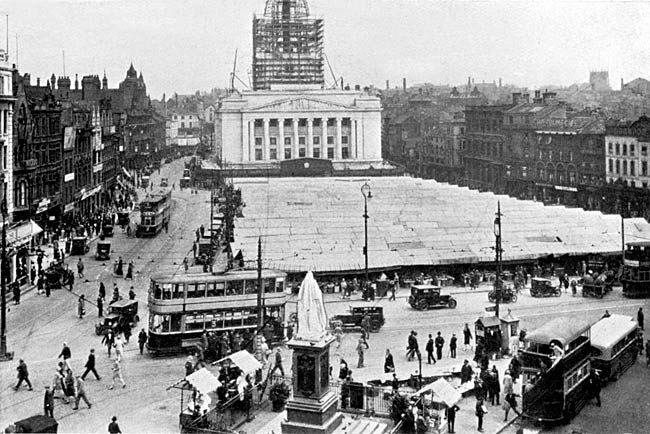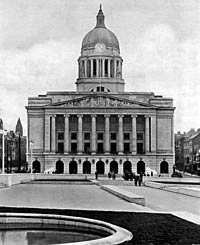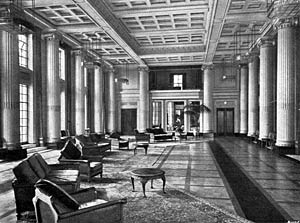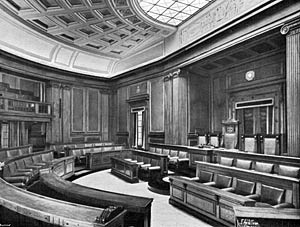< Previous | Contents | Next >
The River Trent and the great Castle Rock are Nature's spectacular gifts to Nottingham, but many other splendid possessions the town has given itself or acquired. It stands on the edge of the romantic old Forest of Sherwood, which still survives in the Dukeries. It is from this forest that the city shares with the county in the rich lore of Robin Hood and his Merry Men. The story goes that Robin himself was a porter at the castle, and that Little John disguised himself as a servant so that he could carry off the sheriff's silver plate.
In these go-ahead days the city has developed as much as any place in England; it has got rid of many of its slums and claims to have built more houses than any other town of its size. It has made Nottingham one of the most wonderfully equipped cities in the kingdom by adding to itself wide roads and boulevards, parks and spaces and playing-fields. It has a fine group of hospitals (one going back to the 18th century), a dozen sets of almshouses and many charities, a high school for boys founded in 1513 and a high school for girls founded last century, and three secondary schools with accommodation for nearly 2000 scholars. It will be seen that Nottingham is a city on a fine scale.

Nottingham market square and Council House under construction in 1928.
We have only to see what it has done with its shabby old market to realise that the Queen of the Midlands has a great imagination. The marketplace was the biggest open-air buying and selling place in England, but it was much too shabby on market days, and the new Nottingham has put the market under cover and laid out this wide space in the centre of the town in a stately way. Where the old stalls stood there are now lawns and flowers and trees and marble walks, and looking down on the square is the Council House, opened in 1929 with a golden key which hangs inside. It is a magnificent building of which any city might be proud, crowned by a striking dome. Some of the facing stone is said to have been marked for St Paul's by Sir Christopher Wren, who had it cut and dressed but did not use it, so that it was left in the quarry.
This great white block which strikes the keynote of 20th century Nottingham was designed by Cecil Howitt. Built at a cost of £500,000, it is stately outside and in, furnished in every detail from doorstep to roof with dignity and great variety.

The Council House in the early 1930s.
The splendid two-storeyed dome is impressive by day and by night, for at night it is floodlit. The plain lower storey has openings on four of its eight sides; the second storey is adorned with four groups of sculpture by old students of the College of Art, the sculptures representing Law, Prosperity, Knowledge, and Commerce. We may climb up 70 steps to this colonnaded storey where we are rewarded with the sight of the bells and the spectacle of the Queen of the Midlands with the country round about her. It is an aerial view of towers and spires and chimneys. On the one hand are the Mapperley Plains, on the other we look over the Trent Valley to Wilford Hill— the height from which we may see one of the fairest views of Nottingham set on its three chief hills, St Mary's, Sneinton, and the Castle Rock. Eastward are Colwick Woods, Sneinton church and Sneinton Mill. By the castle on its mighty rock are the fine houses of the Park, the buildings of the general hospital, and, beyond these, the Elizabethan Wollaton Hall and the 20th century University College. There are five bells in this great dome, weighing over 16 tons, one of them (Little John), said to be the biggest of all tuned bells, weighing 10 tons. Except for great Peter of York, it is the heaviest bell in the provinces, and the hammer for striking the hours on it weighs a quarter of a ton.
The dome looks down from its 200-feet height to the floor of a spacious arcade of shops and offices, approached by great arches from the streets. Round the bottom of the dome we read that the Corporation of Nottingham erected this building for Counsel and Welcome, and to show Merchandise and Crafts. The spandrels of the dome are enriched with frescoes by a Nottingham artist (Noel Denholm Davis), showing in unfading colour four scenes in the city's story: the coming of the Danes, the Conqueror ordering the building of the Castle, Robin Hood and his band, and Charles Stuart raising his standard.
On the ground floor of the Council House front, looking down on the great square, an arcaded portico guarded by two lions leads to the loggia. Above the arcade are eight columns supporting a pediment with sculpture representing the activities of the city. There are about 20 figures and a group of animals sculptured by Joseph Else, principal of the College of Art. In the middle is Justice with scales and a golden sword, her eyes open; Education and Law stand beside her; Labour has a team of horses, and Agriculture has sheep and oxen. Another group represents Motherhood. A mason is erecting a column, a sculptor is carving figures of a woman and a child, there is an artist with his palette and a woman with musical instruments, and a reclining figure is bearing a model of the domed Council House.
Above the great windows of the reception hall, which look on to the square from behind the eight columns, runs a charming frieze with a procession of sturdy children engaged in the arts and crafts and industries in which Nottingham is or has been renowned. There are reapers, weavers, spinners, and iron workers with anvil and forge. Eight children carry a great bell, reminding us of the bell-founders famous here from the 16th to the 18th century; and eight little coal miners are hacking and drawing tubs of coal, reminding us of the days when such children worked in the mines. Children working on the tomb of a knight recall the alabaster carvers famous in medieval centuries, and leather workers represent an industry that is thriving still, 60,000 sheepskins being dressed every week in the city.

Council House Reception Hall.

The Council Chamber.
In the floor of the entrance hall is a mosaic of the city arms made up of 700 pieces. The balustraded staircase is lit by a beautiful dome of 144 panels of amber-tinted glass. At the top of the first flight of steps stands William Reid Dick's bronze figure of a woman holding out her arms in welcome, above her a fine wall painting by Noel Denholm Davis, representing Merchandise, Counsel, Welcome and Crafts. All the floors have panelled rooms with lovely ceilings and hidden lights, or light shining from beautiful electroliers of bronze or crystal. The woodwork is walnut and oak. The reception hall has 20 fine columns and a panelled ceiling, decorated in cream relieved with pink and blue and gold. Its floor is oak, walnut, and pearwood, and at one end is a mirrored wall adding to the charm, while looking down from above are galleries for minstrels and guests. The Lord Mayor's Parlour has on each side of the fireplace and the door exquisite carving in limewood of flowers, fruit, and wheat, and some panelling from Aston Hall in Derbyshire. The handsome dining hall has walnut walls with a striking figured panel over the fireplace, and the room of the lady mayoress is in Adam style with green and gold walls. In the Member's Room the ceiling is enriched with vines, and on the table is the telephone which we are told was the 100,000th instrument installed in the North Midlands. The Council Chamber forms a semi-circle, where every member sits within 26 feet of the lord mayor's chair. The walls are panelled with walnut, with loose tapestry panels over a lining of seaweed, an ingenious device for helping the acoustics of the Chamber. One of the mottoes here is, "Laws are made for the good and safety of the State." There is a small mallet (for the chairman's use) made of oak from a pier of old Trent Bridge, and there are pictures of Old Nottingham by Tom Hammond on the walls of the corridors.
